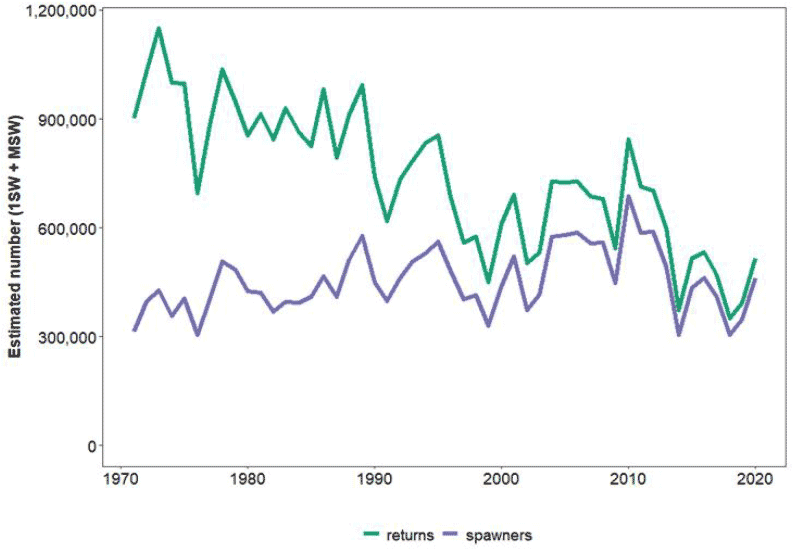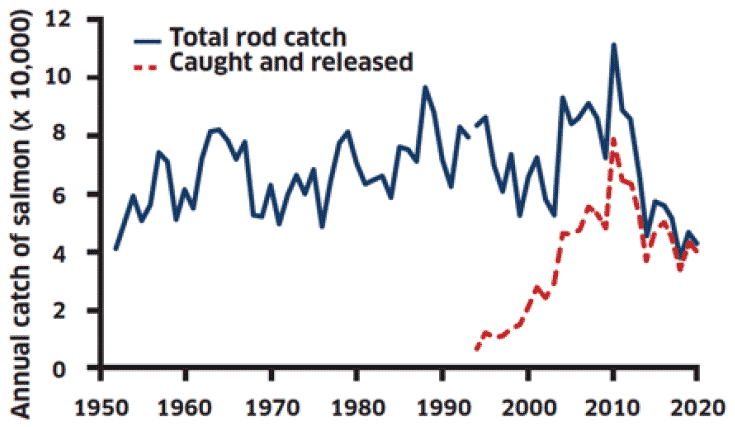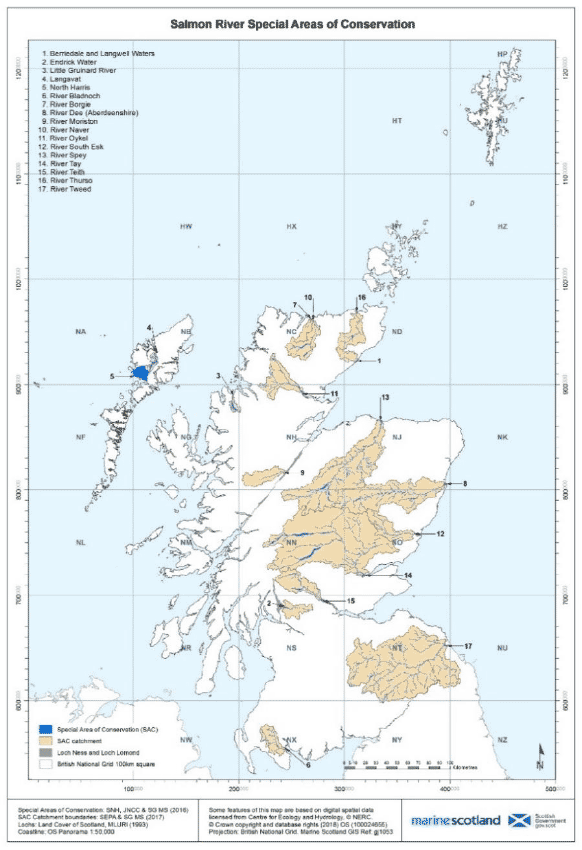Scottish wild salmon strategy
Sets out the vision, objectives and priority themes to ensure the protection and recovery of Scottish Atlantic wild salmon populations.
3. Scotland’s Atlantic salmon
Salmon features highly among the wildlife species readily associated with Scotland by the public. They live in fresh water for 1-4 years before undertaking a long migration north to their oceanic feeding grounds in the North Atlantic. After 1-3 years at sea, adults often return to the river in which they were hatched to spawn and begin the next generation.
This life cycle means they are exposed to a range of threats and pressures in streams, rivers, sea lochs, estuaries, coastal waters and the open ocean. Consequently, conservation of the species requires consideration of how we use the land, how we use water in our rivers and lochs, and how we use our seas, as these habitats can all have an influence on the health of Scotland’s wild salmon populations.
The numbers of salmon returning to Scotland’s coast have declined since the early 1970s (Fig. 1). The estimated numbers of spawning salmon remained steady over this period, before declining from 2010 onwards.

The difference in trends between the two measures is a result of the decline in the removal of salmon by fisheries. The decline in returns to Scottish rivers was compensated for by a reduction in commercial net fisheries and the adoption of catch and release in many rod-and-line fisheries, resulting in the numbers spawning in rivers remaining relatively constant. However, this buffering capacity has now been fully utilised and post-2011 the continued decline in returning salmon has had an impact on the estimated number of salmon spawning in Scottish rivers. Furthermore, reduced growth at sea has caused a decline in the body size of returning salmon, and therefore egg production per fish, further reducing the total numbers of eggs deposited by the spawners.
Marine Scotland Science collects and collates salmon fishery statistics annually as part of a time series that began in 1952.[2] Total rod catch of salmon has generally declined from its peak in 2010. The proportion of fish caught and released rather than being killed, has increased since the mid-1990s and accounted for over 90% of the total rod catch in each of the last 3 years (Fig. 2).

The management of salmon fisheries is supported by an annual assessment of the conservation status of salmon in inland waters. The assessments combine catch returns, fish counter data and environmental factors to assign each river (or groups of rivers where catch data cannot be assigned to individual rivers) a grading based on the probability of achieving its Conservation Limit.[3]
The most recent assessment (for the 2022 fishing season) classifies over half of assessed rivers or groups of rivers (101 out of 173) as being in poor conservation status (Grade 3).[4] The retention of salmon is prohibited in Grade 3 rivers, and catch and release is strongly encouraged in Grade 2 as well as in many Grade 1 rivers.
3.1 Protected status
Atlantic salmon is a protected species and is subject to international conventions as well as national laws and policy:
- The UN Convention for the Conservation of Salmon in the North Atlantic Ocean established the North Atlantic Salmon Conservation Organization (NASCO)[5], which seeks to promote the conservation, restoration, enhancement and rational management of salmon stocks through international consultation and cooperation, taking into account the best scientific evidence available.
- Atlantic salmon are included on the OSPAR list of threatened and/or declining habitats and species, in all the areas where it occurs (OSPAR regions I, II, III and IV)[6].
- Atlantic salmon are listed in Annexes II[7] and V[8] of the EU Habitats Directive. There are 17 Special Areas of Conservation (SACs) for Atlantic salmon in Scotland. Of these, 11 are designated with salmon listed as a primary qualifying interest. These SACs apply to fresh water only (Fig. 3).
- Atlantic salmon are on the Scottish Biodiversity List[9], a list of animals, plants and habitats that Scottish Ministers consider to be of principal importance for biodiversity conservation in Scotland. Ministers have also assigned Priority Marine Feature[10] status to salmon, in terms of the marine component of their lifecycle, in Scottish territorial waters.

3.2 Value of wild Atlantic salmon
Through fisheries and wider nature tourism, salmon are a key component of the rural economy. The latest Scotland-wide economic assessment of wild fisheries (which is dominated by salmon and trout angling) indicated around £135m of angler expenditure, 4,300 full-time equivalent jobs and £79.9m Gross Value Added[11]. Although the intervening years have likely seen a downward trend in these figures, in part due to declining stocks and prohibitions on fishing activities to aid stock recovery, the overall value of Scotland’s salmon remains significant.
The value of salmon to society can also be considered in terms of their ‘non-use value’ linked to their role in the ecology of aquatic ecosystems and as an indicator of high environmental quality. Salmon play a vital role in the functioning of aquatic ecosystems as both predator and prey. The critically endangered freshwater pearl mussel (Margaritifera margaritifera) is dependent on salmon (and brown trout) as a host for the larval stage of its complex life cycle. Through their migration, salmon transfer nutrients from the marine environment into freshwater ecosystems.
Many people consider that salmon and their conservation make a major contribution to their quality of life through the provision of fishing experiences and nature-rich places and it is clear that the Scottish public place importance on the ‘existence value’ of simply having salmon present in our rivers. Historically important as a food resource, salmon have deep cultural connections throughout Scotland and have inspired art and folklore. The remarkable migrations of salmon make them a symbol of strength in the face of adversity, and they feature on the coats of arms of both the City of Glasgow and the Royal Burgh of Peebles.
Contact
There is a problem
Thanks for your feedback